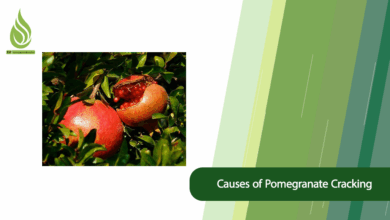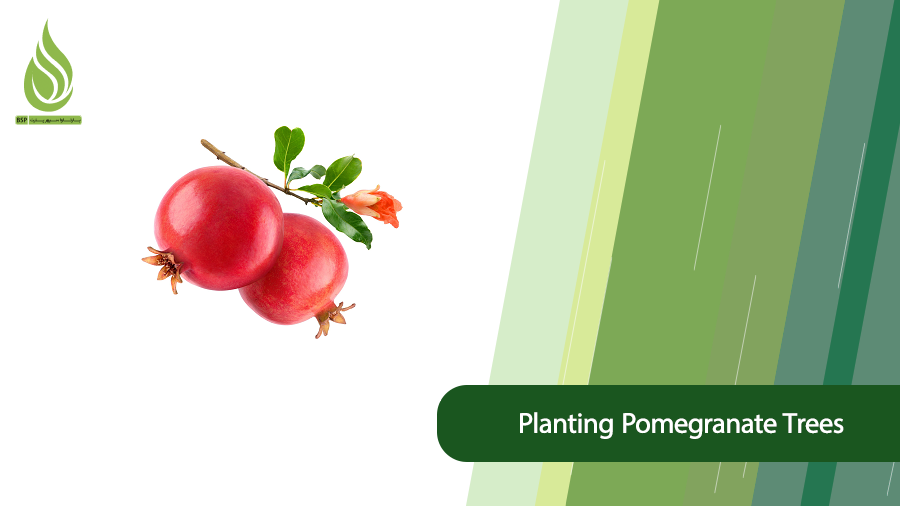
Ideal Conditions for Planting Pomegranate Trees + Fertilization Tips
Pomegranates are an ideal choice for gardening, and their cultivation can help improve the environment and meet nutritional needs. In this article, we explain important tips for planting pomegranate trees and fertilizing this fruit.
Pomegranate: An Ideal Fruit for Gardening
The pomegranate is one of the world’s most beloved fruits, prized for its rich supply of vitamins, fiber, and essential minerals. Its health benefits are extensive, including anti-inflammatory properties, potential cancer-fighting effects, blood pressure regulation, improved memory, relief from arthritis and joint pain, and a reduced risk of heart disease. These attributes, combined with its global popularity, make pomegranate cultivation a profitable venture for growers.
Why Pomegranate Trees are Good for Planting in Gardens
Pomegranate trees are an outstanding choice for gardeners due to their unique advantages:
- Heat and drought tolerance: They thrive in high temperatures and dry climates, adapting well to regions with unpredictable weather.
- Low water requirements: Their ability to survive with minimal irrigation makes them ideal for arid environments.
- Nutritional value: Packed with antioxidants and vitamins, pomegranates boost immune health and overall wellness.
- Market demand: High popularity in local and international markets ensures strong income potential for farmers.
- Ornamental appeal: Beyond fruit production, pomegranate trees enhance gardens with vibrant blooms and striking fruit, serving as decorative additions to green spaces.
With these qualities, pomegranates are not only ideal for sustainable gardening but also contribute to environmental health and food security.
Pomegranate Varieties:
Pomegranate trees come in diverse cultivars suited to specific climates. Popular global varieties include Black Seed, American, Dwarf, and King.
To successfully grow pomegranates, timing and spacing are crucial. Purchase saplings during the optimal planting season for your region and ensure proper spacing when planting in orchards. Also, Choose a cultivar adapted to your local climate.
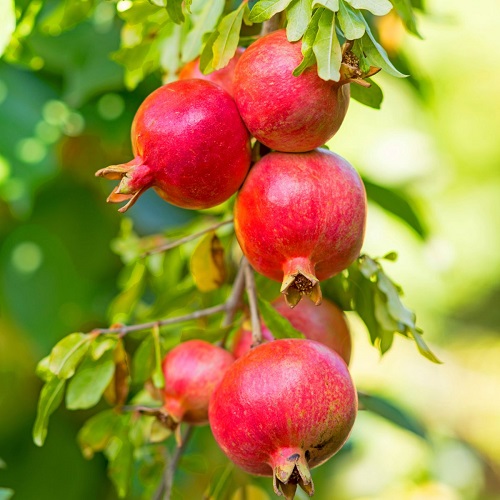
Pomegranate Planting Guide
Climate Requirements
Pomegranate trees thrive in specific climatic conditions to ensure optimal growth and high-quality fruit production. They prefer warm, dry climates and perform best in such environments. Ideal temperatures range between 20–35°C (68–95°F). Pomegranates are sensitive to frost, and temperatures below freezing can damage the tree. In colder regions, planting in sheltered locations (protected from frost) is essential.
Pomegranates grow well in semi-arid regions due to their efficient water use, making them a good choice for cultivation in drought.
Soil Requirements for Planting Pomegranate Trees
Pomegranate saplings require soil with specific characteristics for healthy growth:
- Light, fertile soil: Loamy soil is ideal, as it retains moisture while allowing proper drainage. Sandy soils are acceptable but require more frequent irrigation.
- pH level: Pomegranates prefer slightly alkaline soil with a pH of 7.5–8.5. Acidic soils hinder growth, but these trees are salt tolerant.
- Drainage: Avoid waterlogged soil, as poor drainage can damage roots.
- Organic matter: Enrich soil with compost or manure to boost fertility and microbial activity.
- Planting depth: Dig holes 60–80 cm deep, and ensure soil depth beneath the roots is at least 5 meters to accommodate the tree’s fast-growing vertical roots.
Pomegranate Planting Method
Follow these steps for successful planting:
- Timing: Plant saplings in late Esfand to early Farvardin (late March to early April).
- Sapling selection: Use healthy, pest-resistant saplings from reputable sources. Propagation via cuttings is common.
- Land preparation: Plow the soil, remove weeds/rocks, and add organic matter.
- Hole spacing: Space holes 3–4 meters apart to allow sunlight and nutrient access.
- Planting: Place saplings in holes (60–80 cm wide/deep), spread roots gently, fill with soil, and firm the soil around the base.
- Initial watering: Water thoroughly after planting, avoiding waterlogging.
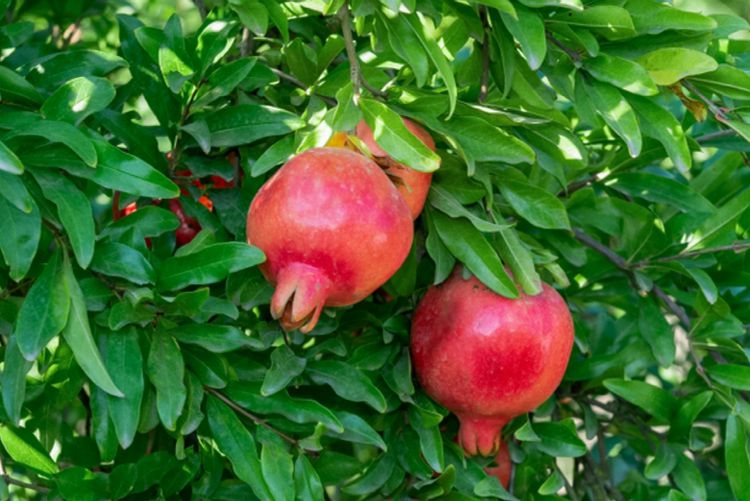
Irrigation
While drought-tolerant, pomegranates need strategic watering for quality fruit:
- Soil type: Sandy soils require more frequent watering and fertilization due to nutrient leaching.
- Methods: Opt for drip irrigation to target roots and conserve water. Avoid overhead methods to reduce evaporation.
- Frequency:
- New saplings: Water moderately to establish roots.
- Hot/dry seasons: Irrigate every 5–7 days.
- Cool/rainy seasons: Reduce frequency. Mature trees require less frequent watering (start with 3x/month, then reduce to 2x/month).
- Timing: Water early morning or evening to minimize evaporation.
Fertilization Schedule for Pomegranate Trees
Understanding the nutritional needs of trees and applying fertilizers at the appropriate times is essential for cultivating various trees, including pomegranates. The most critical step in fertilization is assessing the soil and tree requirements to establish a proper fertilization plan. Conducting a soil test is highly recommended for this purpose. A soil test provides insights into the soil’s pH, salinity levels, texture, and nutrient content. In some cases, soil texture adjustments or pH corrections may be necessary before planting, using standard remediation methods.
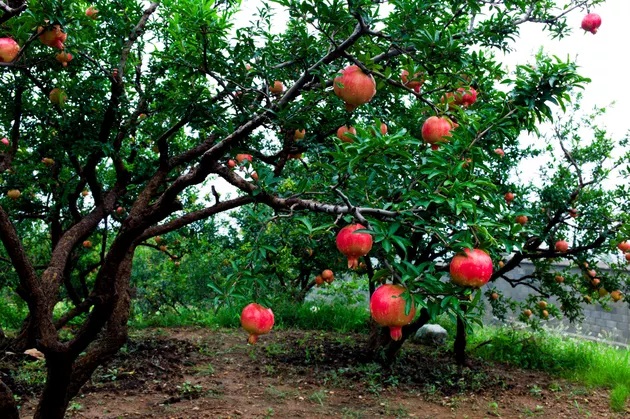
Standard Fertilization Schedule for Pomegranate Trees
Initial Fertilization (Spring):
In early spring, before new growth begins, apply nitrogen and phosphorus-based fertilizers to the soil. This supports vegetative growth. Depending on soil test results, calcium and boron fertilizers may also be added at this stage.
Pre-Flowering Fertilization:
To promote better flowering, use a balanced NPK fertilizer before the flowering phase begins. During flowering, potassium-rich fertilizers can enhance fruit quality and increase yield.
Summer Fertilization:
After fruit formation, when pomegranates reach walnut size, apply iron, calcium, and boron supplements. As the fruit enlarges, prioritize high-potassium fertilizers. Micronutrients can also strengthen the fruit and support growth. For improved color development, apply calcium and boron fertilizers in the final weeks before harvest.
Post-Harvest Fertilization:
In fall, after harvesting, replenish the soil with organic fertilizers and micronutrients to prepare it for the next growing season. Additionally, consider mid-winter fertilization using the basin method (placing fertilizer in trenches around the tree).
By adhering to these guidelines for fertilizer selection and timing, you can optimize tree growth and maximize fruit production.
